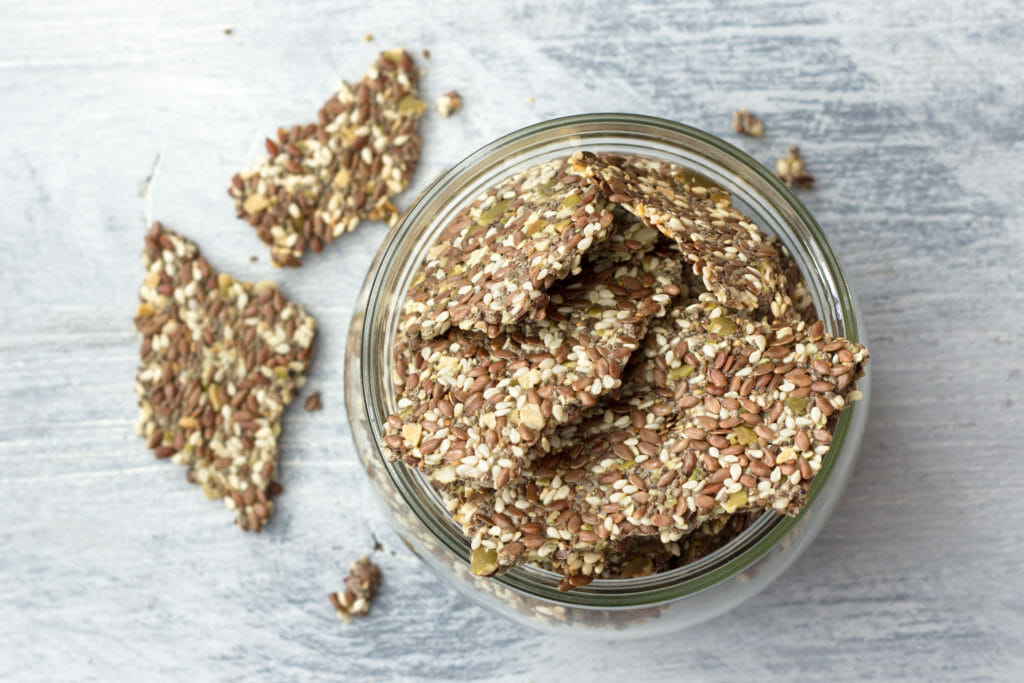How To Make Deliciously Crunchy, Hormone-Friendly Seed Crackers

Seed crackers are delicious and some studies show they can help with hormone balance in more ways than one.
Have you heard of seed cycling?
If you’ve read our seed cycling article you’ll have learned that seeds may help with hormone balance.
Indeed, seed crackers in all sorts of combinations are all the rage right now. We’re not sure if hormone balance is the driver or just plain good health – probably both – but as female hormones go seeds are very helpful.
Seed Research
Moreover, some studies have shown that seeds like flax, pumpkin, sesame and sunflower seeds might help with hormone production. Additionally, plant foods like these support liver detoxification which is crucial for good health. One small study of 30 women showed flaxseeds could potentially reduce hot flashes however it was inconclusive. But watch this space since more and larger studies are generally needed.
Seed crackers are packed with flavour
Whatever the final outcome seed crackers are a delicious snack with feta cheese, avocado, guacamole – whatever topping lights you up. They’re also versatile as you can add other powerhouse seeds like chia or sesame and spice them up or down according to taste.
Recipe Tips
- In this recipe, we used curry powder but you could change it to a dash of chilli or cayenne pepper. Or onion powder as sometimes curry powder can be a tad overpowering.
- Soaking the almonds and pumpkin seeds overnight makes them easier on the digestion.
- Grounding the flaxseeds fresh releases all of the good omega-3s and phytochemicals known as lignans. In addition, flaxseeds are rich in fibre which is an excellent aid for bloating.
- You can make your crackers thicker, or if you prefer them on the thinner side reduce the oven heat to 1500 C.
- Depending on the thickness you choose you may need two trays as this mixture makes quite a lot.
Ingredients:
- 1 C flaxseeds
- 1 C raw almonds
- 1 C raw pumpkin seeds
- 1 C coconut flakes
- 1 tbsp apple cider vinegar
- 1 tsp sea salt
- 1 tbsp
- Water (as needed)
- Flax or almond meal (as needed)
Method:
- Preheat oven to 1800 C or for thinner crackers 1500
- Prepare an oven tray with baking paper
- Grind the flaxseeds. We used an inexpensive coffee grinder to this like this one from Kmart
- Mix all of the seeds together
- Add apple cider vinegar and salt
- Use your fingers to mix it all together
- You should end up with a mixture you can form into a ball
- If it’s too wet or dry to do so, add water or flax/almond meal until you get the consistency you require to form a ball
- Lay it out on the baking paper tray and flatten with your hands
- To get the mixture smoother or thinner use a rolling pin
- Using a sharp knife or pizza cutter cut the mixture into squares
- Bake for 20-25 minutes
- Check them every five or so minutes because if you’re baking them thinner they will cook faster
- Once cooked pull out of the oven and allow to cool (this is when they reach maximum crispness)
Finally, enjoy your seed crackers! 😋






